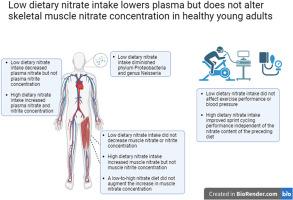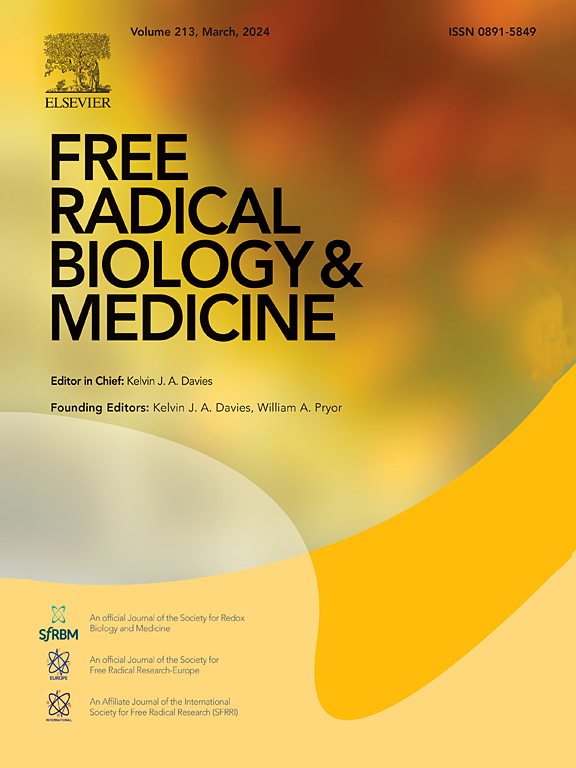Effects of low and high dietary nitrate intake on human saliva, plasma and skeletal muscle nitrate and nitrite concentrations and their functional consequences
IF 7.1
2区 生物学
Q1 BIOCHEMISTRY & MOLECULAR BIOLOGY
引用次数: 0
Abstract
Dietary nitrate (NO3−) supplementation has been shown to reduce blood pressure (BP), improve exercise performance, and alter the oral microbiome. Following a “control” diet (CON), we manipulated dietary NO3− intake to examine the effect of a short-term (7-day) low NO3− diet (LOW) followed by a 3-day high NO3− diet (HIGH), compared to a 7-day standard (STD) NO3− diet followed by HIGH, on saliva, plasma, and muscle [NO3−] and nitrite ([NO2−]), BP, and cycling exercise performance in healthy young adults. We also examined the effect of LOW on the oral microbiome. Saliva [NO3−] and [NO2−], and plasma [NO3−] were significantly lower than CON following LOW (all P < 0.05) but there was no change in plasma [NO2−] or muscle [NO3−] and [NO2−] (all P > 0.05). Following HIGH, saliva and plasma [NO3−] and [NO2−], and muscle [NO3−], were significantly elevated above CON, LOW and STD (all P < 0.05), but there was no difference between CON-LOW-HIGH and CON-STD-HIGH (P < 0.05). BP and exercise performance were not altered following LOW (P > 0.05). HIGH significantly reduced systolic and diastolic BP compared to CON when preceded by STD (both P < 0.05) but not when preceded by LOW (P > 0.05). Peak (+4 %) and mean (+3 %) power output during sprint cycling was significantly improved following HIGH (both P < 0.05), with no differences between CON-LOW-HIGH and CON-STD-HIGH (both P > 0.05). LOW altered the oral microbiome composition, including decreases in relative abundances of phylum Proteobacteria and genus Neisseria. The findings indicate that a short-term low NO3− diet lowers plasma but not skeletal muscle [NO3−]. The maintenance of plasma [NO2−] and muscle [NO3−] and [NO2−] following LOW may be indicative of their importance to biological functions, including BP regulation and exercise performance.

低量和高量膳食硝酸盐摄入对人体唾液、血浆和骨骼肌硝酸盐和亚硝酸盐浓度的影响及其功能性后果。
膳食硝酸盐(NO3-)补充剂已被证明可降低血压(BP)、改善运动表现并改变口腔微生物组。在 "对照 "饮食(CON)之后,我们对膳食中的硝酸盐摄入量进行了调整,以研究短期(7 天)低硝酸盐饮食(LOW)和随后 3 天的高硝酸盐饮食(HIGH)对健康年轻人唾液、血浆、肌肉[NO3-]和亚硝酸盐[NO2-]、血压以及骑车运动表现的影响。我们还研究了 LOW 对口腔微生物组的影响。LOW 后,唾液[NO3-]和[NO2-]以及血浆[NO3-]明显低于 CON(均为 P2-)或肌肉[NO3-]和[NO2-](均为 P>0.05)。HIGH 后,唾液和血浆[NO3-]和[NO2-]以及肌肉[NO3-]明显高于 CON、LOW 和 STD(均为 P0.05)。与 CON 相比,在 STD 之前,HIGH 能明显降低收缩压和舒张压(均为 P0.05)。HIGH 后,冲刺骑车时的峰值功率输出(+4%)和平均功率输出(+3%)明显提高(均为 P0.05)。低氧改变了口腔微生物组的组成,包括减少了变形菌门和奈瑟氏菌属的相对丰度。研究结果表明,短期低 NO3- 饮食会降低血浆[NO3-],但不会降低骨骼肌[NO3-]。低NO3-饮食后血浆[NO2-]和肌肉[NO3-]及[NO2-]的维持可能表明它们对生物功能(包括血压调节和运动表现)的重要性。
本文章由计算机程序翻译,如有差异,请以英文原文为准。
求助全文
约1分钟内获得全文
求助全文
来源期刊

Free Radical Biology and Medicine
医学-内分泌学与代谢
CiteScore
14.00
自引率
4.10%
发文量
850
审稿时长
22 days
期刊介绍:
Free Radical Biology and Medicine is a leading journal in the field of redox biology, which is the study of the role of reactive oxygen species (ROS) and other oxidizing agents in biological systems. The journal serves as a premier forum for publishing innovative and groundbreaking research that explores the redox biology of health and disease, covering a wide range of topics and disciplines. Free Radical Biology and Medicine also commissions Special Issues that highlight recent advances in both basic and clinical research, with a particular emphasis on the mechanisms underlying altered metabolism and redox signaling. These Special Issues aim to provide a focused platform for the latest research in the field, fostering collaboration and knowledge exchange among researchers and clinicians.
 求助内容:
求助内容: 应助结果提醒方式:
应助结果提醒方式:


